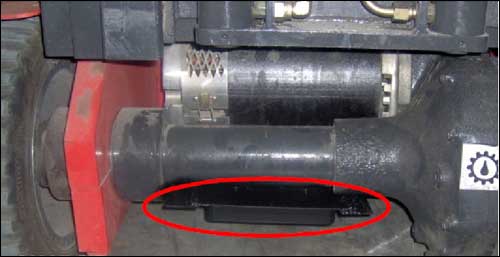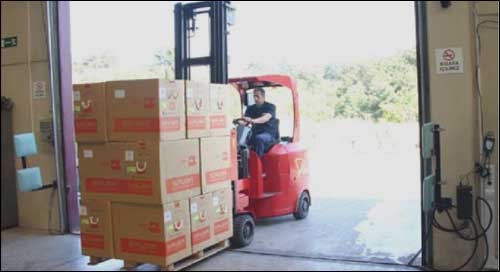Tetas Textiles, a Turkish provider of equipment and supplies for the textiles industry, has expanded its use of radio frequency identification to include an employee-tracking system linked to an information system used to manage its fleet of cars. The data collected by the car information system—such as a vehicle’s fuel consumption and whereabouts—can be combined with personnel information culled via RFID, along with data regarding goods collected via bar code. Together, this information enables managers to have a real-time overview of the status of particular products being delivered by individual employees.
Tetas, based in Istanbul, developed its own car information system that employs GPS, GPRS and RFID technologies. Before an employee is assigned a particular delivery in a major Turkish city, the car’s ID number and the customer’s order information are input into the company’s computer system via bar code. Upon entering the car, the worker uses that vehicle’s information system’s integrated RFID reader to scan the 13.56 MHz NXP Semiconductors Mifare RFID chip in his ID card, which is also used to access buildings owned by Tetas. Employees can utilize the car system during deliveries of products, such as sewing machines, office supplies and spare parts, as well as for visiting customers on sales calls. The GPS system in the car information system helps drivers navigate, and the vehicle’s location coordinates are communicated via GPRS so managers can track employees’ whereabouts. By combining all of this data, managers can know which workers are driving which cars with which delivery orders, and where those cars are located at any given time.

“The goods start to become more intelligent, in the sense that we know if goods are in a specific location along the delivery route—that the driver has or has not yet delivered them,” says Moris Yaffe, Tetas’ general manager, who described his company’s RFID deployment at the EPC Europe Conference, held last month in Germany, in conjunction with RFID Journal LIVE! Europe 2009. The company began implementing the car information system six months ago, completing its installation in October. To date, it has outfitted roughly 110 vehicles, including three trucks, with the device.
Tetas rents most of the cars in its fleet, and wants to monitor its costs closely. The firm also wants to use the information to manage employees—that is, to know when, where and why personnel use specific vehicles.
With the data collected via the car information system, Yaffe explains, Tetas can cost out each different process used to carry out the services the company provides. People working in the sales department use most of the cars, he says, and managers may need to know if salespeople are visiting their assigned customers. The car information system, which provides managers with maps and reports, also makes it easy for the company to check which employees use each car, as well as if a vehicle is being driven on weekends and after work hours.
Managers in the company’s logistics department also employ the car information system to closely monitor the number of kilometers driven by each car, as a way to evaluate shipping performance, using the data to calculate the cost of each journey.
The project was not Tetas’ first foray into radio frequency identification. In 2006, the company implemented RFID to track pallets at its 8,500-square-meter (91,500-square-foot) warehouse in Tekbes, near Izmir. Before RFID was implemented, Tetas did not use any form of electronic identification for tracking the 25,000 different items it supplies to its 6,000 customers, most of which are apparel manufacturers. Since implementing the system, the company has rolled out RFID at all six of its warehouses, and has integrated the technology with its Oracle E-Business Suite.

The system works with pallets that are tagged with ultrahigh-frequency (UHF) passive tags complying with the EPC Gen 2 standard. RFID interrogators and antennas installed on forklifts identify the pallets. When a driver unloads a pallet on a high rack, the forklift reader identifies the rack and shelf numbers. In addition, as the vehicle moves about within the warehouse, another antenna on the bottom of the forklift identifies EPC Gen 2 RFID tags embedded in the floor, thus identifying the vehicle’s location. When goods pass through the warehouse’s entrances and exits, RFID interrogators installed at those locations read the passive tags on the pallets.
The combined information provides Tetas with a real-time overview of the exact locations of all goods within its warehouse, and enables it to take inventory quickly. “It now takes us two hours to count the warehouse,” Yaffe states. “We increased efficiency by 30 to 35 percent.”
The company purchased a variety of RFID interrogators to outfit its 20 forklifts and its doorways. It uses 10 Siemens fixed readers, as well as nine handheld ATID interrogators and one handheld Nordic ID reader for spot identification of tagged objects. The handheld units operate on RFID software provided by Reva Systems. Most of the 13,000 tags used each year in the application are supplied by UPM Raflatac. Tetas developed its own middleware for the system, and served as its own project integrator.
At the launch of the implementation, Tetas had been tagging pallets with two RFID tags apiece—but Yaffe says that actually complicated the system. “We found that the more tags you have, the more complicated and error-prone the system can be,” he explains. For this reason, he says, the company now applies only one RFID tag per pallet, and it has fine-tuned the system to achieve 99 percent read rates.
The Tetas group of companies includes two that produce apparel for export, and one that manufactures textile and packaging labels, as well as stationary. Tetas employs RFID to track paper reels that it supplies to commercial printers. The reels measure 100 centimeters (39 inches) in diameter and 64 centimeter (25 inches) tall, and weigh 673 kilograms (1,481 pounds) each.
The company usually identifies the rolls via their bar-code labels, and assigns the rolls to specific pallets fitted with EPC Gen 2 RFID tags. In some cases, however, the firm attaches EPC Gen 2 RFID tags to the actual rolls, since it must track specific details about the paper, such as its quality and weight. Given the rolls’ extreme weight and size, as well as how they are stored in high racks, RFID proved to be an ideal way to identify the goods. Workers can approach shelves full of rolls, read each roll’s RFID tag with a handheld interrogator and determine the product details immediately, without having to search for a bar code.
In yet another RFID project, Tetas designed an RFID-based system to improve the visitor experience at trade shows, and to collect customer information. The system, named IZ-TAN-BUL—which, Yaffe explains, translates roughly to “trace, recognize and locate”—relies on active and passive RFID tags. Salespeople working at Tetas’ booth wear active Wi-Fi tags so their movements can be tracked over a Wi-Fi network. Customers that visit Tetas’ booth are assigned EPC Gen 2 UHF tags that are used for identification, as well as for purchasing drinks through an RFID-enabled soda machine that demonstrates RFID in an entertaining and thirst-quenching manner. RFID interrogators installed at various sections of the booth read the customers’ tags as they come into range. By interpreting the data, the company can find out which customers browsed which part of its booth the longest, and also track the number of visitors.
Given Tetas’ wide experience with various RFID technologies and systems, the Turkish government and private companies have encouraged the firm to provide RFID technology to other companies and industries as well. To that end, Tetas is developing a yard-management system for a car importer based on RFID, bar-code, GPS and GPRS technologies. The system is expected to be finished soon, and will eventually be available on the market.


